一、Redission分布式锁原理
基于setnx实现的分布式锁存在下面的问题:

1. Redission介绍
Redisson是一个在Redis的基础上实现的Java驻内存数据网格(In-Memory Data Grid)。它不仅提供了一系列的分布式的Java常用对象,还提供了许多分布式服务。其中包括(BitSet, Set, Multimap, SortedSet, Map, List, Queue, BlockingQueue, Deque, BlockingDeque, Semaphore, Lock, AtomicLong, CountDownLatch, Publish / Subscribe, Bloom filter, Remote service, Spring cache, Executor service, Live Object service, Scheduler service) Redisson提供了使用Redis的最简单和最便捷的方法。Redisson的宗旨是促进使用者对Redis的关注分离(Separation of Concern),从而让使用者能够将精力更集中地放在处理业务逻辑上。
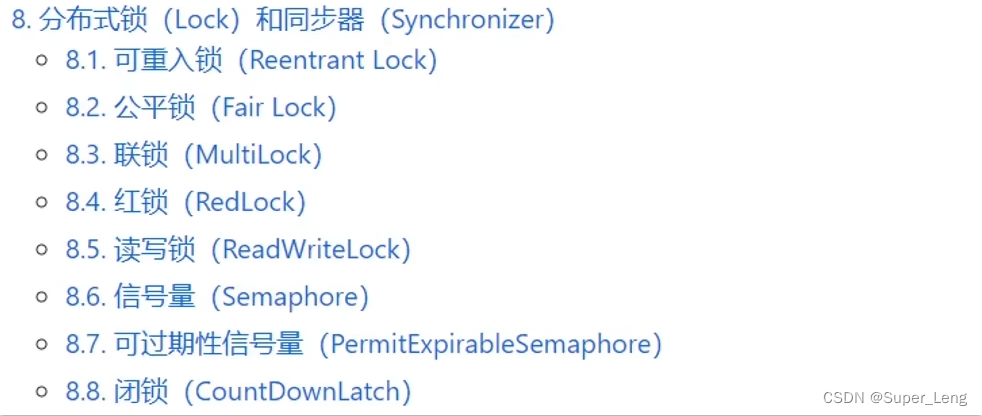
官网地址: https://redisson.org
GitHub地址: https://github.com/redisson/redisson
2. Redission基本使用
(1)引入依赖
<dependency>
<groupId>org.redisson</groupId>
<artifactId>redisson</artifactId>
<version>3.13.6</version>
</dependency>
(2)配置Redisson客户端
@Configuration
public class RedissonConfig {
@Bean
public RedissonClient redissonClient(){
// 配置类
Config config = new Config();
// 添加redis地址,这里添加了单点的地址,也可以使用config.useClusterServers()添加集群地址
config.useSingleServer().setAddress("redis://192.168.150.101:6379")
.setPassword("123321");
// 创建客户端
return Redisson.create(config);
}
}
(3)使用Redission的分布式锁
@Resource
private RedissionClient redissonClient;
@Test
void testRedisson() throws Exception{
//获取锁(可重入),指定锁的名称
RLock lock = redissonClient.getLock("anyLock");
//尝试获取锁,参数分别是:获取锁的最大等待时间(期间会重试),锁自动释放时间,时间单位
boolean isLock = lock.tryLock(1, 10, TimeUnit.SECONDS);
//判断获取锁成功
if(isLock){
try{
System.out.println("执行业务");
}finally{
//释放锁
lock.unlock();
}
}
}
改造上一章中的VoucherOrderServiceImpl,使用Redisson分布式锁:
@Service
public class VoucherOrderServiceImpl extends ServiceImpl<VoucherOrderMapper, VoucherOrder> implements IVoucherOrderService {
@Resource
private ISeckillVoucherService seckillVoucherService;
@Resource
private RedisIdWorker redisIdWorker;
@Resource
private StringRedisTemplate stringRedisTemplate;
@Resource
private RedissonClient redissonClient;
@Override
public Result seckillVoucher(Long voucherId) {
// 1.查询优惠券
SeckillVoucher voucher = seckillVoucherService.getById(voucherId);
// 2.判断秒杀是否开始
if (voucher.getBeginTime().isAfter(LocalDateTime.now())) {
// 尚未开始
return Result.fail("秒杀尚未开始!");
}
// 3.判断秒杀是否已经结束
if (voucher.getEndTime().isBefore(LocalDateTime.now())) {
// 尚未开始
return Result.fail("秒杀已经结束!");
}
// 4.判断库存是否充足
if (voucher.getStock() < 1) {
// 库存不足
return Result.fail("库存不足!");
}
Long userId = UserHolder.getUser().getId();
// 使用Redis分布式锁
// 创建锁对象
// SimpleRedisLock lock = new SimpleRedisLock("order:" + userId, stringRedisTemplate);
// 使用Redisson分布式锁
RLock lock = redissonClient.getLock("lock:order:" + userId);
// 获取锁对象
// 无参的tryLock(),默认等待时间是-1表示一直等待,过期时间默认是30s
boolean isLock = lock.tryLock();
// 加锁失败
if (!isLock) {
return Result.fail("不允许重复下单");
}
try {
// 获取代理对象(事务)
IVoucherOrderService proxy = (IVoucherOrderService) AopContext.currentProxy();
return proxy.createVoucherOrder(voucherId);
} finally {
// 释放锁
lock.unlock();
}
}
}
经测试后,Redisson分布式锁也可以防止一人多单场景
3. Redission可重入锁原理
(1)可重入锁流程分析
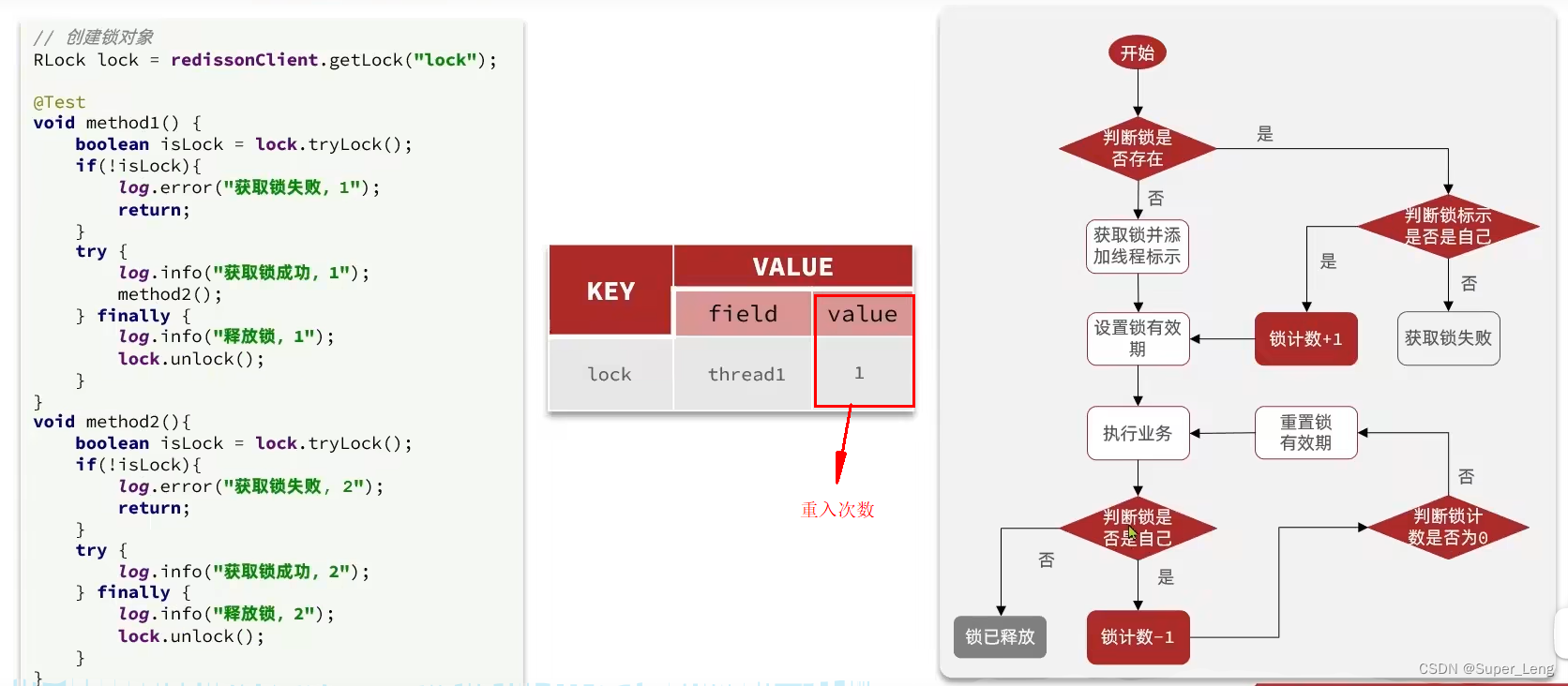
注意:这里的存放锁的数据结构是Hash结构,因为多了一个字段value存重入次数
为了保证获取锁和释放锁的原子性,需要分别通过Lua脚本进行获取锁和释放锁:
- 获取锁的Lua脚本
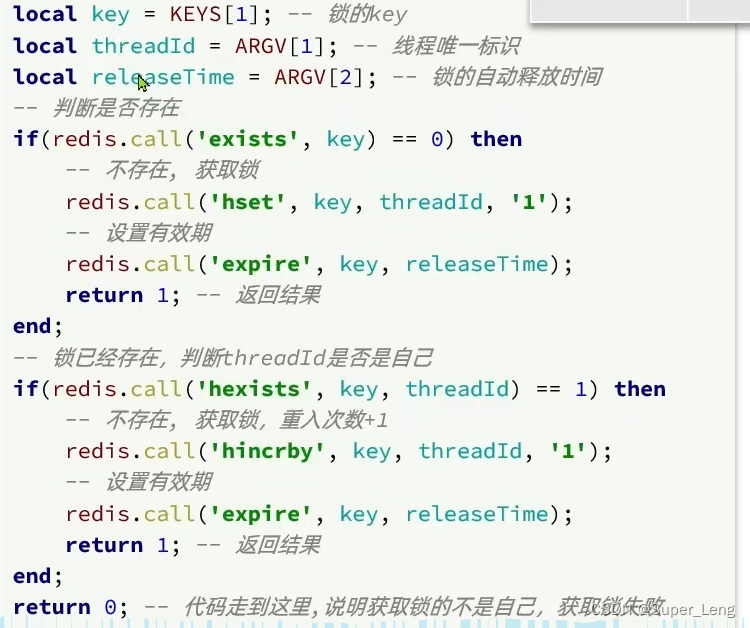
- 释放锁的Lua脚本

(2)演示可重入锁
编写测试方法:
@Slf4j
@SpringBootTest
class RedissonTest {
@Resource
private RedissonClient redissonClient;
private RLock lock;
@BeforeEach
void setUp() {
lock = redissonClient.getLock("order");
}
@Test
void method1() throws InterruptedException {
// 尝试获取锁
boolean isLock = lock.tryLock(1L, TimeUnit.SECONDS);
if (!isLock) {
log.error("获取锁失败 .... 1");
return;
}
try {
log.info("获取锁成功 .... 1");
method2();
log.info("开始执行业务 ... 1");
} finally {
log.warn("准备释放锁 .... 1");
lock.unlock();
}
}
void method2() {
// 尝试获取锁
boolean isLock = lock.tryLock();
if (!isLock) {
log.error("获取锁失败 .... 2");
return;
}
try {
log.info("获取锁成功 .... 2");
log.info("开始执行业务 ... 2");
} finally {
log.warn("准备释放锁 .... 2");
lock.unlock();
}
}
}
2022-07-29 11:04:38.030 INFO 3244 --- [ main] com.hmdp.RedissonTest : 获取锁成功 .... 1
2022-07-29 11:04:44.859 INFO 3244 --- [ main] com.hmdp.RedissonTest : 获取锁成功 .... 2
2022-07-29 11:04:45.343 INFO 3244 --- [ main] com.hmdp.RedissonTest : 开始执行业务 ... 2
2022-07-29 11:04:47.307 WARN 3244 --- [ main] com.hmdp.RedissonTest : 准备释放锁 .... 2
2022-07-29 11:04:52.796 INFO 3244 --- [ main] com.hmdp.RedissonTest : 开始执行业务 ... 1
2022-07-29 11:04:53.309 WARN 3244 --- [ main] com.hmdp.RedissonTest : 准备释放锁 .... 1
(3)Redisson源码分析
Redisson锁的接口:
public interface RLock extends Lock, RLockAsync {
String getName();
void lockInterruptibly(long leaseTime, TimeUnit unit) throws InterruptedException;
boolean tryLock(long waitTime, long leaseTime, TimeUnit unit) throws InterruptedException;
void lock(long leaseTime, TimeUnit unit);
boolean forceUnlock();
boolean isLocked();
boolean isHeldByThread(long threadId);
boolean isHeldByCurrentThread();
int getHoldCount();
long remainTimeToLive();
}
调用Redisson锁的尝试加锁、释放锁的方法:
private RLock lock;
// 尝试获取锁
boolean isLock = lock.tryLock();
// 释放锁
lock.unlock();
RedissonLock尝试加锁源码:
public class RedissonLock extends RedissonExpirable implements RLock {
// 1
@Override
public boolean tryLock() {
return get(tryLockAsync());
}
// 2
@Override
public RFuture<Boolean> tryLockAsync() {
return tryLockAsync(Thread.currentThread().getId());
}
// 3
@Override
public RFuture<Boolean> tryLockAsync(long threadId) {
// 由此可知,调用无参的tryLock()方法时,waitTime默认等待时间是-1
return tryAcquireOnceAsync(-1, -1, null, threadId);
}
// 4
private RFuture<Boolean> tryAcquireOnceAsync(long waitTime, long leaseTime, TimeUnit unit, long threadId) {
if (leaseTime != -1) {
return tryLockInnerAsync(waitTime, leaseTime, unit, threadId, RedisCommands.EVAL_NULL_BOOLEAN);
}
// 调用无参的tryLock()方法时,leaseTime会被赋值为-1,所以执行到这里
// 最终将leaseTime默认设置为30s(long lockWatchdogTimeout = 30 * 1000;)
// 该方法是异步Future方法
RFuture<Boolean> ttlRemainingFuture = tryLockInnerAsync(waitTime,
commandExecutor.getConnectionManager().getCfg().getLockWatchdogTimeout(),
TimeUnit.MILLISECONDS, threadId, RedisCommands.EVAL_NULL_BOOLEAN);
ttlRemainingFuture.onComplete((ttlRemaining, e) -> {
if (e != null) {
return;
}
// lock acquired
if (ttlRemaining) {
scheduleExpirationRenewal(threadId);
}
});
return ttlRemainingFuture;
}
// 5 此处就是底层源码尝试加锁的lua脚本
<T> RFuture<T> tryLockInnerAsync(long waitTime, long leaseTime, TimeUnit unit, long threadId, RedisStrictCommand<T> command) {
internalLockLeaseTime = unit.toMillis(leaseTime);
return evalWriteAsync(getName(), LongCodec.INSTANCE, command,
"if (redis.call('exists', KEYS[1]) == 0) then " +
"redis.call('hincrby', KEYS[1], ARGV[2], 1); " +
"redis.call('pexpire', KEYS[1], ARGV[1]); " +
"return nil; " + // 获取锁成功返回nil
"end; " +
"if (redis.call('hexists', KEYS[1], ARGV[2]) == 1) then " +
"redis.call('hincrby', KEYS[1], ARGV[2], 1); " +
"redis.call('pexpire', KEYS[1], ARGV[1]); " +
"return nil; " + // 获取锁成功返回nil
"end; " +
"return redis.call('pttl', KEYS[1]);", // 获取锁失败返回锁的剩余有效时间,pttl表示以毫秒为单位
Collections.singletonList(getName()), internalLockLeaseTime, getLockName(threadId));
}
}
RedissonLock释放锁源码:
// 1
@Override
public void unlock() {
try {
get(unlockAsync(Thread.currentThread().getId()));
} catch (RedisException e) {
if (e.getCause() instanceof IllegalMonitorStateException) {
throw (IllegalMonitorStateException) e.getCause();
} else {
throw e;
}
}
}
// 2
@Override
public RFuture<Void> unlockAsync(long threadId) {
RPromise<Void> result = new RedissonPromise<Void>();
RFuture<Boolean> future = unlockInnerAsync(threadId);
future.onComplete((opStatus, e) -> {
cancelExpirationRenewal(threadId);
if (e != null) {
result.tryFailure(e);
return;
}
if (opStatus == null) {
IllegalMonitorStateException cause = new IllegalMonitorStateException("attempt to unlock lock, not locked by current thread by node id: "
+ id + " thread-id: " + threadId);
result.tryFailure(cause);
return;
}
result.trySuccess(null);
});
return result;
}
// 3 此处就是底层源码释放锁的lua脚本
protected RFuture<Boolean> unlockInnerAsync(long threadId) {
return evalWriteAsync(getName(), LongCodec.INSTANCE, RedisCommands.EVAL_BOOLEAN,
"if (redis.call('hexists', KEYS[1], ARGV[3]) == 0) then " +
"return nil;" +
"end; " +
"local counter = redis.call('hincrby', KEYS[1], ARGV[3], -1); " +
"if (counter > 0) then " +
"redis.call('pexpire', KEYS[1], ARGV[2]); " +
"return 0; " +
"else " +
"redis.call('del', KEYS[1]); " +
"redis.call('publish', KEYS[2], ARGV[1]); " + // 释放锁后,会publish发送通知
"return 1; " +
"end; " +
"return nil;",
Arrays.asList(getName(), getChannelName()), LockPubSub.UNLOCK_MESSAGE, internalLockLeaseTime, getLockName(threadId));
}
4. Redisson可重试原理
调用Redisson锁的带等待时间的尝试加锁方法:
private RLock lock;
// 尝试获取锁,传入等待时间
boolean isLock = lock.tryLock(1L, TimeUtil.SECONDS);
Redisson带等待时间的尝试加锁源码:
// 1
@Override
public boolean tryLock(long waitTime, TimeUnit unit) throws InterruptedException {
return tryLock(waitTime, -1, unit);
}
// 2
@Override
public boolean tryLock(long waitTime, long leaseTime, TimeUnit unit) throws InterruptedException {
// 将等待时间转为毫秒
long time = unit.toMillis(waitTime);
long current = System.currentTimeMillis();
long threadId = Thread.currentThread().getId();
// 尝试获取锁,最终会调到尝试获取锁的lua脚本
Long ttl = tryAcquire(waitTime, leaseTime, unit, threadId);
// lock acquired
if (ttl == null) { // 返回nil表示获取锁成功
return true;
}
// System.currentTimeMillis() - current 表示前面代码执行的时间
// time -= System.currentTimeMillis() - current 表示剩余等待时间
time -= System.currentTimeMillis() - current;
if (time <= 0) { // 没有剩余等待时间,则直接返回获取锁失败
acquireFailed(waitTime, unit, threadId);
return false;
}
current = System.currentTimeMillis();
// 上一步获取锁失败后,则会在此等待并订阅其他线程释放锁的通知
RFuture<RedissonLockEntry> subscribeFuture = subscribe(threadId);
// 在剩余等待时间内还没收到释放锁的通知,则会取消订阅并返回获取锁失败
if (!subscribeFuture.await(time, TimeUnit.MILLISECONDS)) {
if (!subscribeFuture.cancel(false)) {
subscribeFuture.onComplete((res, e) -> {
if (e == null) {
// 取消订阅
unsubscribe(subscribeFuture, threadId);
}
});
}
acquireFailed(waitTime, unit, threadId);
// 返回失败
return false;
}
try {
// 继续计算剩余等待时间
time -= System.currentTimeMillis() - current;
if (time <= 0) {
acquireFailed(waitTime, unit, threadId);
return false;
}
while (true) {
long currentTime = System.currentTimeMillis();
// 再次重试获取锁
ttl = tryAcquire(waitTime, leaseTime, unit, threadId);
// lock acquired
if (ttl == null) {
return true;
}
time -= System.currentTimeMillis() - currentTime;
if (time <= 0) {
acquireFailed(waitTime, unit, threadId);
return false;
}
// waiting for message
currentTime = System.currentTimeMillis();
// 通过信号量getLatch(),再次等待其他线程释放锁
if (ttl >= 0 && ttl < time) {
subscribeFuture.getNow().getLatch().tryAcquire(ttl, TimeUnit.MILLISECONDS);
} else {
subscribeFuture.getNow().getLatch().tryAcquire(time, TimeUnit.MILLISECONDS);
}
time -= System.currentTimeMillis() - currentTime;
if (time <= 0) {
acquireFailed(waitTime, unit, threadId);
return false;
}
}
} finally {
unsubscribe(subscribeFuture, threadId);
}
// return get(tryLockAsync(waitTime, leaseTime, unit));
}
5. Redisson的WatchDog机制
- WatchDog机制(看门狗机制),主要是给锁续期,防止业务没执行完而将锁错误释放
- 注意:当自己不设置有效期时,leaseTime会被默认设为-1时,此时才有WatchDog机制;如果自己设置了有效期,则没有WatchDog机制
WatchDog机制源码:
private <T> RFuture<Long> tryAcquireAsync(long waitTime, long leaseTime, TimeUnit unit, long threadId) {
if (leaseTime != -1) {
return tryLockInnerAsync(waitTime, leaseTime, unit, threadId, RedisCommands.EVAL_LONG);
}
// 异步Future方法
RFuture<Long> ttlRemainingFuture = tryLockInnerAsync(waitTime,
commandExecutor.getConnectionManager().getCfg().getLockWatchdogTimeout(),
TimeUnit.MILLISECONDS, threadId, RedisCommands.EVAL_LONG);
// 当tryLockInnerAsync回调完成后,执行该方法
// ttlRemaining表示剩余有效期,e表示异常
ttlRemainingFuture.onComplete((ttlRemaining, e) -> {
// 有异常时,直接返回
if (e != null) {
return;
}
// lock acquired
if (ttlRemaining == null) { // 执行加锁lua脚本返回nil时,表示加锁成功
// 自动给锁续期
scheduleExpirationRenewal(threadId);
}
});
return ttlRemainingFuture;
}
private void scheduleExpirationRenewal(long threadId) {
ExpirationEntry entry = new ExpirationEntry();
// EXPIRATION_RENEWAL_MAP是ConcurrentHashMap(private static final ConcurrentMap<String, ExpirationEntry> EXPIRATION_RENEWAL_MAP = new ConcurrentHashMap<>();)
// getEntryName()是获取当前锁的名称
// 所有的Redisson分布式锁都会存到EXPIRATION_RENEWAL_MAP中
ExpirationEntry oldEntry = EXPIRATION_RENEWAL_MAP.putIfAbsent(getEntryName(), entry);
// addThreadId(threadId);记录该线程获取锁的次数
// 注意,只是第一次加锁时,将定时任务存到ExpirationEntry中,后面再重入时该任务仍然存在,所以不需要再设置,即不用调用renewExpiration()方法
if (oldEntry != null) {
oldEntry.addThreadId(threadId);
} else {
entry.addThreadId(threadId);
// 第一次加锁时,会更新有效期,即续期
renewExpiration();
}
}
private void renewExpiration() {
ExpirationEntry ee = EXPIRATION_RENEWAL_MAP.get(getEntryName());
if (ee == null) {
return;
}
// 创建延时任务
// internalLockLeaseTime / 3 表示三分之一的有效时间之后,再执行续期任务
Timeout task = commandExecutor.getConnectionManager().newTimeout(new TimerTask() {
@Override
public void run(Timeout timeout) throws Exception {
ExpirationEntry ent = EXPIRATION_RENEWAL_MAP.get(getEntryName());
if (ent == null) {
return;
}
Long threadId = ent.getFirstThreadId();
if (threadId == null) {
return;
}
// 更新有效期,底层通过lua脚本,pexpire命令进行重新赋值有效时间
RFuture<Boolean> future = renewExpirationAsync(threadId);
// 回调完成后,递归调用renewExpiration()方法
future.onComplete((res, e) -> {
if (e != null) {
log.error("Can't update lock " + getName() + " expiration", e);
return;
}
if (res) {
// reschedule itself
// 递归调用renewExpiration()方法,这样就实现了不断续期机制
renewExpiration();
}
});
}
}, internalLockLeaseTime / 3, TimeUnit.MILLISECONDS);
// 将定时任务存到ExpirationEntry中,后面将会不断续期
// 注意,只是第一次加锁时,将定时任务存到ExpirationEntry中,后面再重入时该任务仍然存在,所以不需要再设置,即不用调用renewExpiration()方法
ee.setTimeout(task);
}
// 底层通过lua脚本,pexpire命令进行重新赋值有效时间
protected RFuture<Boolean> renewExpirationAsync(long threadId) {
return evalWriteAsync(getName(), LongCodec.INSTANCE, RedisCommands.EVAL_BOOLEAN,
"if (redis.call('hexists', KEYS[1], ARGV[2]) == 1) then " +
"redis.call('pexpire', KEYS[1], ARGV[1]); " +
"return 1; " +
"end; " +
"return 0;",
Collections.singletonList(getName()),
internalLockLeaseTime, getLockName(threadId));
}
释放锁时,取消定时续期任务:
lock.unlock() -> unlockAsync(Thread.currentThread().getId()) -> cancelExpirationRenewal(threadId)
void cancelExpirationRenewal(Long threadId) {
// 通过锁的名称获取该锁的定时任务并移除掉
ExpirationEntry task = EXPIRATION_RENEWAL_MAP.get(getEntryName());
if (task == null) {
return;
}
if (threadId != null) {
task.removeThreadId(threadId);
}
if (threadId == null || task.hasNoThreads()) {
Timeout timeout = task.getTimeout();
if (timeout != null) {
timeout.cancel();
}
EXPIRATION_RENEWAL_MAP.remove(getEntryName());
}
}
6. 小结:Redisson分布式锁原理
Redisson分布式锁原理:
- 可重入:利用hash结构记录线程id和重入次数
- 可重试:利用信号量和PubSub功能实现等待、唤醒,获取锁失败的重试机制(使用等待唤醒机制,避免过多占用CPU,提高性能)
- 超时续约:利用watchDog,每隔一段时间(releaseTime / 3),重置超时时间
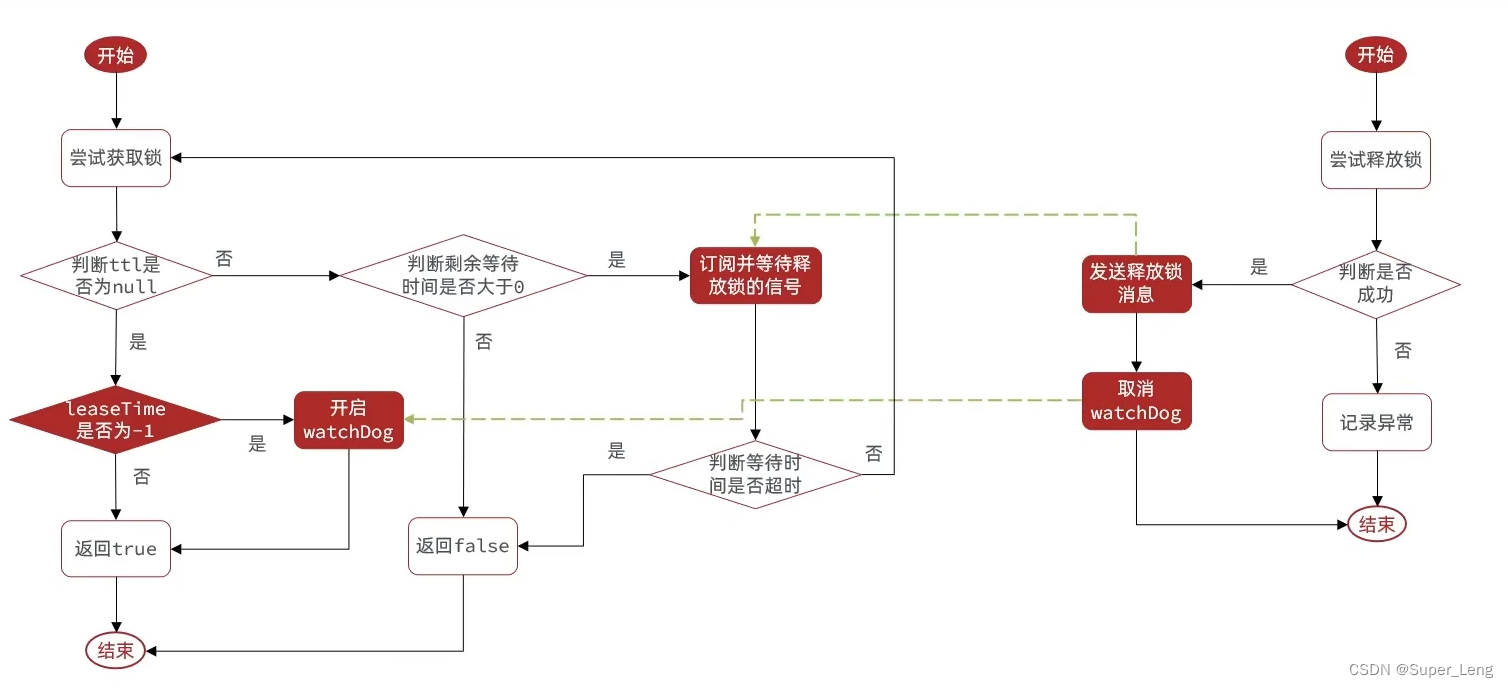
二、Redission锁的MutiLock原理
1. Redisson分布式锁主从一致性问题
- 如果只有一台redis服务器,当redis挂掉后,依赖redis的业务都会受影响,所以为了提高redis的可用性,则需要搭建redis的主从模式
- 一般会通过一主多从,实现读写分离;主节点处理所有写操作,从节点处理所有读操作;
- 从节点需要通过主从同步后,才会有数据,但是主从同步时,存在延时,有延时就会导致主从一致性问题
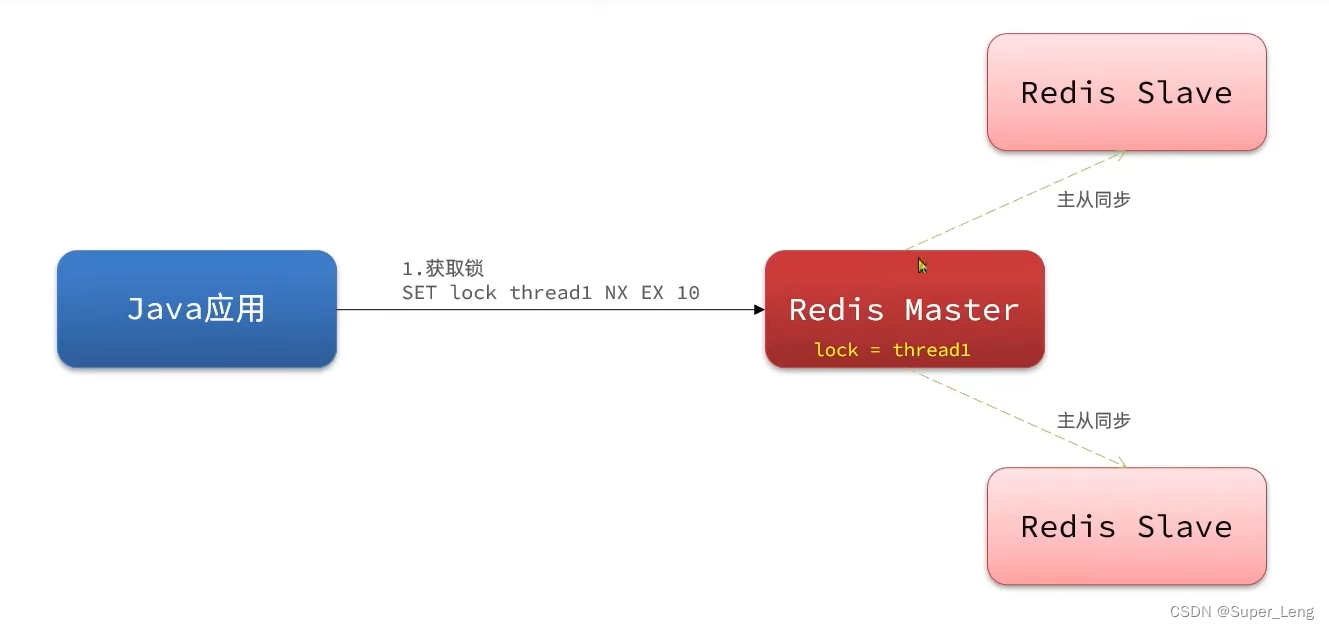
- 当主节点挂掉时,会选一个从节点作为新的主节点
- 当新主节点没来得及同步之前挂掉的旧主节点的锁数据时,此时新主节点没有锁数据,所以相当于之前获取的锁都将失效
- 这时,其他线程就会获取锁成功,造成并发安全问题

2. Redisson使用MutiLock解决主从一致性问题
- MutiLock表示联锁,将多个节点的锁联合在一起
- 由于主从模式会导致一致性问题,所以Redisson将每个节点都视为主节点,所有节点都是独立的,每个节点都能进行读写操作
- 此时获取锁的方式是:依次从每个节点获取锁,都获取成功才算成功
- 如果想提高可用性,每个主节点可以再创建各自的从节点
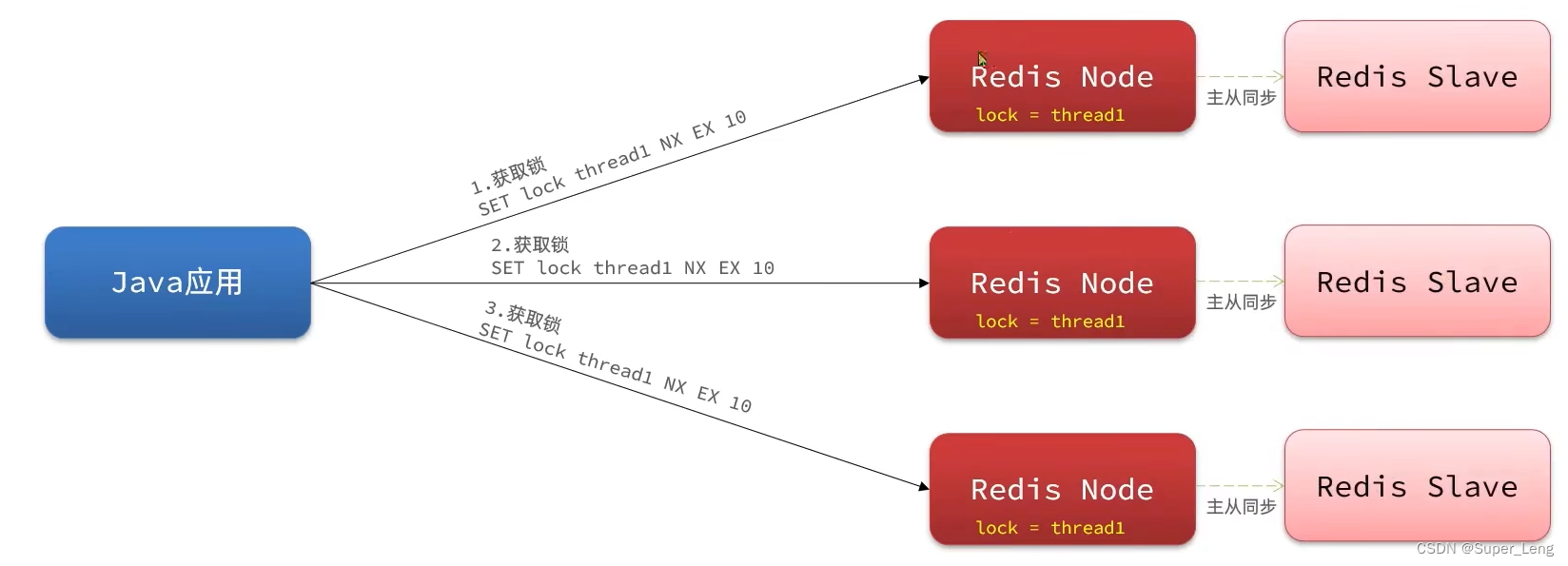
- 就算有一个主节点挂掉,造成锁失效,但是只要其他任意一个主节点的锁没失效,新来的线程就会加锁失败,这样就避免了并发安全问题

(1)演示MutiLock
配置3个节点6379、6380、6381,演示MutiLock:
@Configuration
public class RedissonConfig {
@Bean
public RedissonClient redissonClient(){
// 配置类
Config config = new Config();
// 添加redis地址,这里添加了单点的地址,也可以使用config.useClusterServers()添加集群地址
config.useSingleServer().setAddress("redis://127.0.0.1:6379").setPassword("123321");
// 创建客户端
return Redisson.create(config);
}
@Bean
public RedissonClient redissonClient2(){
Config config = new Config();
config.useSingleServer().setAddress("redis://127.0.0.1:6380").setPassword("123321");
return Redisson.create(config);
}
@Bean
public RedissonClient redissonClient3(){
Config config = new Config();
config.useSingleServer().setAddress("redis://127.0.0.1:6381").setPassword("123321");
return Redisson.create(config);
}
}
编写测试方法:
@Slf4j
@SpringBootTest
class RedissonTest {
@Resource
private RedissonClient redissonClient;
@Resource
private RedissonClient redissonClient2;
@Resource
private RedissonClient redissonClient3;
private RLock lock;
@BeforeEach
void setUp() {
RLock lock1 = redissonClient.getLock("order");
RLock lock2 = redissonClient2.getLock("order");
RLock lock3 = redissonClient3.getLock("order");
// 创建联锁,MultiLock
lock = redissonClient.getMultiLock(lock1, lock2, lock3);
}
@Test
void method1() throws InterruptedException {
// 尝试获取锁
boolean isLock = lock.tryLock(1L, TimeUnit.SECONDS);
if (!isLock) {
log.error("获取锁失败 .... 1");
return;
}
try {
log.info("获取锁成功 .... 1");
method2();
log.info("开始执行业务 ... 1");
} finally {
log.warn("准备释放锁 .... 1");
lock.unlock();
}
}
void method2() {
// 尝试获取锁
boolean isLock = lock.tryLock();
if (!isLock) {
log.error("获取锁失败 .... 2");
return;
}
try {
log.info("获取锁成功 .... 2");
log.info("开始执行业务 ... 2");
} finally {
log.warn("准备释放锁 .... 2");
lock.unlock();
}
}
}
测试结果:

- 联锁就是将每个独立的锁联合在一起,每个独立的锁加锁原理跟Redisson分布式锁原理相同,只是每个独立的锁都加锁成功后,才表示加锁成功
(2)RedissonMultiLock 原理
RedissonMultiLock源码:
public class RedissonMultiLock implements RLock {
@Override
public boolean tryLock(long waitTime, TimeUnit unit) throws InterruptedException {
return tryLock(waitTime, -1, unit);
}
@Override
public boolean tryLock(long waitTime, long leaseTime, TimeUnit unit) throws InterruptedException {
long newLeaseTime = -1;
// 如果自己设置了有效期leaseTime,则执行这里;如果没设置有效期,则leaseTime默认为-1,不执行这里
if (leaseTime != -1) {
// 等待时间waitTime为-1表示只会等待锁释放,不会去重试获取锁
if (waitTime == -1) {
newLeaseTime = unit.toMillis(leaseTime);
} else {
// 等待时间waitTime不为-1表示锁获取失败后,想要继续重试获取锁
// 并且将有效期重新设置为waitTime的2倍,防止等待重试期间,锁到达有效期而被释放,所以有效时间需要比等待时间长才行
newLeaseTime = unit.toMillis(waitTime)*2;
}
}
long time = System.currentTimeMillis();
long remainTime = -1;
if (waitTime != -1) {
// 当传入了自己设置的等待时间时,将会使用自己设置的等待时间作为剩余等待时间
remainTime = unit.toMillis(waitTime);
}
// 锁等待的时间lockWaitTime 就是剩余等待时间remainTime
long lockWaitTime = calcLockWaitTime(remainTime);
// failedLocksLimit()这个值是0,即failedLocksLimit = 0
int failedLocksLimit = failedLocksLimit();
// 获取锁成功的集合,locks是所有独立锁的集合(final List<RLock> locks = new ArrayList<>();)
List<RLock> acquiredLocks = new ArrayList<>(locks.size());
// 遍历locks联锁中每个独立的锁
for (ListIterator<RLock> iterator = locks.listIterator(); iterator.hasNext();) {
RLock lock = iterator.next();
boolean lockAcquired;
try {
// lock.tryLock()就是RedissonLock中尝试获取锁的方法
if (waitTime == -1 && leaseTime == -1) {
lockAcquired = lock.tryLock();
} else {
long awaitTime = Math.min(lockWaitTime, remainTime);
lockAcquired = lock.tryLock(awaitTime, newLeaseTime, TimeUnit.MILLISECONDS);
}
} catch (RedisResponseTimeoutException e) {
unlockInner(Arrays.asList(lock));
lockAcquired = false;
} catch (Exception e) {
lockAcquired = false;
}
if (lockAcquired) {
// 每个独立的锁获取成功后,都会加入到获取锁成功的集合中
acquiredLocks.add(lock);
} else { // 获取锁失败后,执行else里面逻辑
// 这里是跳出for循环的条件
if (locks.size() - acquiredLocks.size() == failedLocksLimit()) {
break;
}
// failedLocksLimit初始值就是0,所以满足该条件
if (failedLocksLimit == 0) {
// 先释放成功获取锁的集合
unlockInner(acquiredLocks);
// waitTime为-1表示不会进行重试,则第一次失败,就直接返回失败
if (waitTime == -1) {
return false;
}
// waitTime不为-1表示获取锁失败后,想继续重试获取锁
failedLocksLimit = failedLocksLimit();
// 先清空成功获取锁的集合
acquiredLocks.clear();
// reset iterator
// 重新从独立锁集合的第一个锁开始遍历
while (iterator.hasPrevious()) {
iterator.previous();
}
// 继续进入for循环重试获取锁,直到获取锁成功或者没有剩余等待时间后,退出循环
} else {
failedLocksLimit--;
}
}
// 判断剩余时间
if (remainTime != -1) {
remainTime -= System.currentTimeMillis() - time;
time = System.currentTimeMillis();
if (remainTime <= 0) {
// 获取锁超时后,先将之前获取锁成功的集合释放,然后再返回失败
unlockInner(acquiredLocks);
return false;
}
}
// 如果还有剩余时间,则继续执行for循环,遍历下一个独立锁
}
// 如果自己设置了锁的有效期leaseTime,则会执行这里;
// 否则leaseTime默认为-1,不会执行这里,而是通过WatchDog机制续期
if (leaseTime != -1) {
List<RFuture<Boolean>> futures = new ArrayList<>(acquiredLocks.size());
// 所有锁获取成功后,遍历每个成功获取的锁,重新设置有效期
// 因为每个独立锁是依次获取的,
// 例如:第一个锁获取成功后,还需要等最后一个锁也获取成功,等待的过程中,前面的锁的有效期提前倒计时消耗了一部分
// 所以,当所有锁获取成功后,需要重新设置有效期,保证所有锁的有效期从头开始倒计时
for (RLock rLock : acquiredLocks) {
RFuture<Boolean> future = ((RedissonLock) rLock).expireAsync(unit.toMillis(leaseTime), TimeUnit.MILLISECONDS);
futures.add(future);
}
for (RFuture<Boolean> rFuture : futures) {
rFuture.syncUninterruptibly();
}
}
return true;
}
}
三、分布式锁总结
1. 不可重入Redis分布式锁:
- 原理:利用setnx的互斥性;利用ex避免死锁;释放锁时判断线程标识
- 缺陷:不可重入、无法重试、锁超时失效
2. 可重入的Redis分布式锁:
- 原理:利用hash结构,记录线程标识和重入次数;利用watchDog延续锁时间;利用信号量控制锁重试等待
- 缺陷:redis宕机引起锁失效问题
3. Redisson的multiLock:
- 原理:多个独立的Redis节点,必须在所有节点都获取重入锁,才算获取锁成功
- 缺陷:运维成本高、实现复杂





















 152
152











 被折叠的 条评论
为什么被折叠?
被折叠的 条评论
为什么被折叠?








